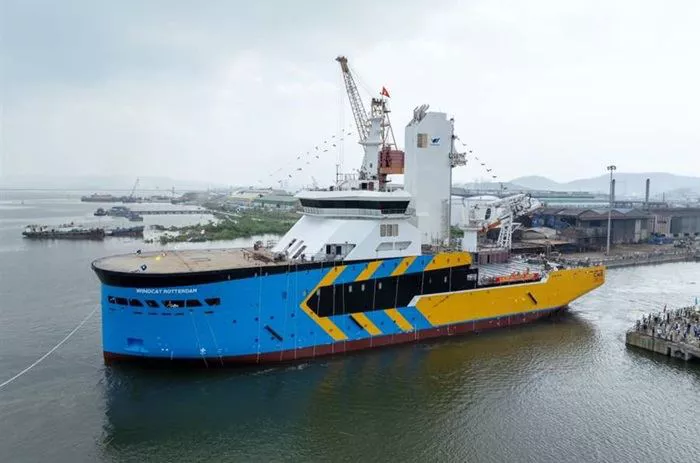Damen Shipyards, in collaboration with Windcat and CMB.TECH, has officially launched the first of six Commissioning Service Operation Vessels (CSOV), heralding the introduction of the Windcat “Elevation Series” designed for sustainable offshore wind farm maintenance. The partnership, first announced in 2022, initially contracted for two vessels but expanded the order to six by mid-2024.
The launch event took place on October 12 at Ha Long Shipyard in Vietnam, where Damen is actively constructing the vessels. Outfitting and commissioning operations are set to continue, with plans to deliver the first vessel in the second quarter of 2025.
Measuring 87 meters in length and 20 meters in width, the new CSOV can accommodate up to 120 personnel on board, allowing for in-field technical and maintenance support at offshore locations for up to 30 days. Emphasis has been placed on ensuring comfortable living and working conditions for offshore crews.
The CSOV features the innovative CMB.TECH dual fuel hydrogen technology, previously used in the Windcat Hydrocat Crew Transfer Vessel (CTV). The Hydrocat operates with two MAN D2862 LE488 engines, retrofitted by CMB.TECH with a hydrogen injection system and fuel tanks capable of storing 207 kg of hydrogen. The Elevation Series will utilize hydrogen as a fuel source, aligning with the evolving energy market.
Willem van der Wel, managing director of Windcat, expressed the company’s commitment to becoming a leader in energy-efficient and future fuel shipping. “We want to use hydrogen from day one upon delivery of these vessels to ensure we learn from it now and can quickly scale up when the supply chain matures,” he stated.
Joost van der Weiden, Damen’s sales manager for the Benelux region, highlighted the vessel’s anticipated efficiency improvements. “The hybrid-electric propulsion system, combined with an efficient power distribution setup, eliminates the need for a backup diesel generator, ensuring the vessel consumes only the power necessary,” he said.
The design also incorporates an optimized thruster configuration for enhanced dynamic positioning during transfer operations. Van der Weiden concluded, “We expect these innovations to lead to significant reductions in fuel consumption and emissions, contributing to a greener future for the industry.”
Related topics:
- Yanmar CE Showcases Cutting-Edge Compact Equipment at Equip Exposition
- Future of Trucking Takes Center Stage at IAA Transportation Show
- Ørsted Unveils 600MW Solar and Storage Project in Arizona

